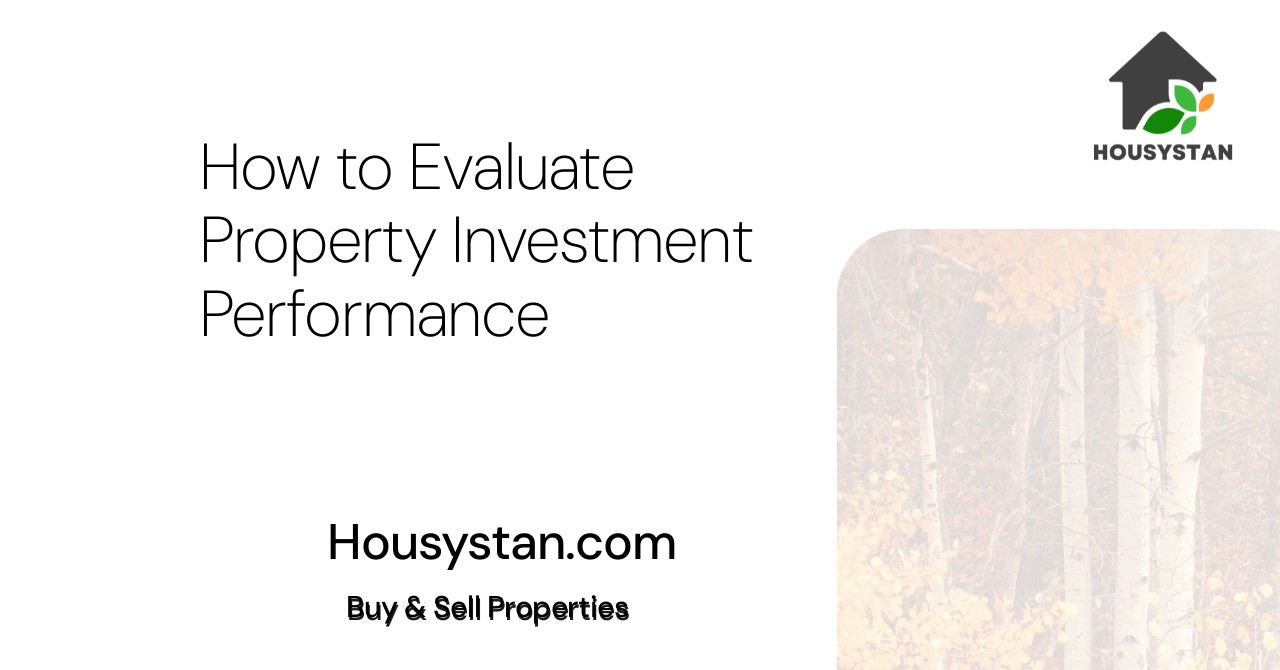How to Evaluate Property Investment Performance
Read latest blogs and articles from Housystan

The Information mentioned here was last updated on:
4/1/2026How to Evaluate Property Investment Performance
Investing in property can be a rewarding venture, offering both financial security and potential for future growth. However, understanding how to evaluate property investment performance is crucial to maximizing returns and minimizing risk. In this guide, we explore practical strategies for assessing property investments, ensuring you have the tools and knowledge necessary to make informed decisions.
Understanding Key Metrics
- Verified Tenants/Buyers
- Unlimited Property Listing
- Zero subscription/charges fee
In the world of property investment, several metrics are essential for evaluating performance. These key indicators can help you assess the viability and profitability of a property.
Gross Rental Yield
Gross rental yield measures the annual rental income generated by a property relative to its purchase price. Calculating this yield can give you a quick snapshot of potential returns.
- Formula: (Annual Rental Income / Property Purchase Price) x 100
- Tip: Look for properties with a higher gross rental yield as they typically offer better cash flow.
Net Rental Yield
Net rental yield provides a more accurate picture by accounting for expenses such as maintenance, insurance, and property taxes.
- Formula: [(Annual Rental Income - Annual Expenses) / Property Purchase Price] x 100
- Consider: Evaluate properties with strong net rental yields, which indicate effective cost management and solid returns.
Cash-on-Cash Return
This metric evaluates the return on investment relative to the amount of cash you’ve invested.
- Formula: (Annual Cash Flow / Total Cash Invested) x 100
- Insight: A higher cash-on-cash return signals better investment performance and efficient use of capital.
Capital Appreciation
Capital appreciation refers to the increase in property value over time, impacting your overall return.
- Monitoring: Keep an eye on market trends and property value forecasts to gauge potential appreciation.
- Long-term Vision: Consider properties in rapidly developing areas to maximize appreciation potential.
Analyze Market Trends
Keeping abreast of market trends is vital to evaluating property investment performance. Understanding the local and broader real estate market helps anticipate changes that could affect your investment.
Local Market Conditions
- Supply and Demand: Consider the number of properties available versus demand from buyers or renters. A demand higher than supply typically drives up prices and rents.
- Economic Factors: Investigate local employment rates, industry growth, and infrastructure developments, as they can influence property value and rental income.
National Market Trends
- Interest Rates: Monitor national interest rate trends, as they impact mortgage rates and property affordability.
- Legislative Changes: Stay informed about potential changes in property laws and tax regulations that could affect your investment returns.
Conduct Property Evaluation
Before proceeding with any property investment, a thorough evaluation is essential. Here’s how to effectively assess a potential property.
Property Inspection
- Condition Check: Inspect the property's physical condition, identifying any necessary repairs or renovations that could impact costs.
- Structural Integrity: Assess for potential issues in the foundation, roofing, plumbing, and electrical systems.
Location Analysis
- Accessibility: Consider the property's proximity to public transportation, schools, workplaces, and essential amenities.
- Neighborhood Profile: Examine the overall safety, growth potential, and community reputation, impacting desirability and value.
Leverage Technology
Technology offers various tools and resources that can streamline the evaluation process of property investments.
Online Platforms
- Property Listings: Utilize online platforms such as Zillow or Realtor.com to compare property prices and rental rates.
- Investment Calculators: Use online calculators to assess potential returns and explore “what-if” scenarios.
Data Analytics Tools
- Market Data Access: Access comprehensive property and market data to identify trends and opportunities.
- Predictive Analytics: Consider using platforms with predictive analytics to forecast market changes and property performance.
Optimize Investment Management
Once you’ve invested in property, managing it efficiently is crucial for sustained performance.
Cost Management
- Expense Tracking: Maintain detailed records of all property-related expenses to streamline tax filing and financial analysis.
- Budgeting: Set a budget for maintenance and unexpected repairs to prevent financial strain.
Tenant Relations
- Screening Process: Implement a robust tenant screening process to secure reliable renters and minimize turnover.
- Communication: Maintain open lines of communication with tenants for a positive rental experience, enhancing tenant retention.
Continuous Performance Monitoring
Investments require regular evaluation to ensure they meet financial goals and adapt to changing market conditions.
Regular Reviews
- Monthly and Annual Reports: Create regular reports outlining income, expenses, and key performance metrics.
- Performance Benchmarks: Compare your property's performance against local and national benchmarks to identify areas for improvement.
Adaptation Strategies
- Reinvestment: Assess opportunities for reinvestment, such as property upgrades or acquiring additional properties.
- Exit Strategy: Develop an exit strategy in the event the investment no longer aligns with your financial objectives.
Stay Informed and Educated
Lastly, continuing to educate yourself on property investment will ensure you remain equipped to make savvy decisions.
Industry Publications
- Reading Materials: Subscribe to industry magazines and newsletters to gain insights from real estate experts.
- Networking: Engage with other investors through forums or local meetups to share knowledge and experiences.
Courses and Seminars
- Professional Development: Participate in courses and seminars focused on property investment and management skills.
- Expert Insights: Attend seminars to hear from successful investors and industry leaders.
By thoroughly understanding these principles and regularly applying them to the management of your property investments, you can ensure robust assessment and informed decision-making. This approach not only helps in achieving your financial goals but also strengthens your ability to navigate the ever-evolving real estate market.